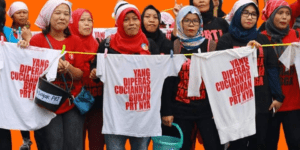After being passed down from generation to generation, can we ever break free from menstrual taboo?
The taboo metaphor against menstruation is practically hereditary. For a long time, menstruation has always been associated with something that is dirty, impure, filthy, and all of its matters thus should be properly concealed in society. Menstruation seems to be a despicable and forbidden thing to be used as a topic of discussion in public spaces.
Tracing Back Early History’s Menstruation
The unfavorable presumptions that emerged can be linked back to the influence of the ancient Greek and Roman empires. Menstrual blood was regarded at the time as a filthy material containing poison.
Menstruating women in Judaism are required to dwell in menstruation huts, which are specific shelters made for menstruation women to isolate themselves in caves. Women in the old times were forbidden from interacting with their family, having sex, and even touching some sorts of food (Fingerson, 2007).
To let others know when they were bleeding, women in that time had to wear personal identification as a signal of warning. History of the usage of cosmetics begins here. Jewelry comprising bracelets, necklaces, rings, earrings, slippers, sandals, lipstick, eyeliner, and headscarf are actually products of menstruation (Grahn, 1994). All of those objects were developed and put to use by many cultural civilizations, each with their own set of rules with the common goal of preventing the violation of their respective menstruation beliefs.
Gifted Stories from the Past Generations
That story had an influence on how the menstrual taboo developed today. In the past, in Indonesia, a girl who was going through menarche, or her first period, would be embarrassed to mention that she was menstruating, especially if men knew about it (Lestari, 2015). This inheritance has been foisted onto girls up until this point. Menstruation is usually described in narratives as being disturbing and disgraceful for women to go through. This affects how public discourse on issues relating to menstruation is expressed.
For instance, the use of euphemisms for key words related to menstruation. Through what can be observed in the social environment, for example at school, young girls clearly often hear the use of code words such as “lagi M“, “lagi dapet“, or “lagi datang bulan” just to refer to menstruation.
This phenomenon also occurs in the use of the code words “roti sobek” or “roti jepang” to refer to pads. It seems that females have been advised to avoid using the phrase explicitly since they were young, as though doing so is highly forbidden. Due to a lack of conversational space, it affects how females from a young age seldom obtain enough knowledge and awareness about their own reproductive health.
This situation then creates the never-ending loop effect. Restrictions on menstruation talk that have been passed down for generations, which then limited the public awareness about menstruation, will re-validate the socio- cultural belief that menstruation is disgusting (Joseph, 2017). This activity goes round and round within the society and just continues to preserve the presence of menstrual taboo.
Holding Women Back in Patriarchal Society
Menstrual taboo is often recognized as one of the foundations of patriarchy theory. The most significant impact on gender relations was the resurgence of pre-existing social norms that forbade menstruating women from working. Menstruating women are restricted from their regular activities (e.g., education and employment) because of the physical discomfort. They are not trusted to do the job effectively with the condition. As a result, it perpetuates a culture that discredits women in contemporary social processes. The unconscious bias brought on by the persistence of menstruation taboo creates the glass ceiling effect, an imperceptible barrier that prevents women from achieving the high levels of education, professional experience, and other privileges they all rightfully and equally deserve.
In this scenario, the setting can thus be deemed to have had a significant impact on the gender and development (GAD) paradigm, which is how a society allocates roles, obligations, and expectations to both men and women.
The GAD gap demonstrates the severity of the barriers preventing women from obtaining equal rights to independent livelihoods. Women in patriarchal societies are perceived as less competent than males due to disparities in employment and education. As a result, men and women often pursue careers in distinct industries and occupations, with female-dominated fields and lower-paying positions (WGEA, 2021). Later, the discriminatory actions turn into elements that promote the gender pay gap.
Additionally, this circumstance has an impact on gender performativity, or how men and women perform in terms of gender expectations and norms. According to Judith Butler (1990), most of the time, what society perceives as an individual’s gender is really a performance put on to meet societal standards and not a true representation of the individual’s gender identity. In this way, menstrual taboo contributes to the development of gender norms and expectancies, where women are expected to be more vulnerable and frail, whilst men are more strong and assertive.
As a result, men and women are frequently forced to ‘obey’ these traditions, with males being expected to provide for the family financially and women not seeking further education because their place is at home.
Moving Forward: From Taboo To Empowerment
In the positive light. There are indeed many ways that can help us break free from the legacy of menstrual taboo and all of its unfavorable implications. One of the core ground efforts is to stop passing the behavior and culture down to the younger generations.
For the never-ending cycle to cease, we must break it, and the key to do so is through empowering. Menstruation-related dialogues should be encouraged by society since the more we speak about it, the better we understand it. It might begin by making terms associated with menstruation more commonplace. We must abandon the practice of euphemizing menstruation and dare to educate the younger generation with accurate information instead (i.e., sanitary and hygiene access, myths that are falsehoods). Due to the fact that understanding menstruation is important to every human being in a highly complex dimension, we also need to include the males in this discussion.
The idea is because gender mainstreaming, one of the strategies used to address gender disparity, requires the transmission of information and awareness to begin with. In order to realize the goal of a gender-responsive society where women and men can evenly contribute to and benefit from development, gender mainstreaming is crucial as a fundamental key to ensure that the government seeks gender equality in all sectors of the process (Peterson and Jordansson, 2021). In conclusion, eradicating the legacy of the menstrual taboo is crucial due to its impact on a variety of areas, including gender and development and gender mainstreaming, all of which are crucial for realizing the universal goal of gender equality.
References
Butler, J. (1990). Gender Trouble: Feminism and the Subversion of Identity. London: Routledge.
Fingerson, L. (2007). Girls in Power: Gender, Body and Menstruation in Adolescence. New York: State University of New York Press.
Grahn, J. (1994). Blood, Bread, and Roses: How Menstruation Created the World. Boston: Beacon Press.
Joseph, S. (2017). Menstrual taboos and ancient wisdom. [online] Hindu American Foundation. Available at: https://www.hinduamerican.org/blog/menstrual-taboos-and-ancient-wisdom.
Lestari, L. (2015). Menstrual Taboo and the Social Control of the Women in Muhammad ‘Izzah Darwazah Perspective: The Intertextuality Study on the Qur’an and the Bibel. pp.1–21.
Peterson, H. and Jordansson, B. (2021). Gender mainstreaming in Swedish academia: translating policy into practice. Journal of Gender Studies, 31(1), pp.1–14. doi:10.1080/09589236.2021.2004539.Workplace Gender Equality Agency (2021). The Gender Pay Gap. [online] www.wgea.gov.au. Available at: https://www.wgea.gov.au/the-gender-pay-gap.













